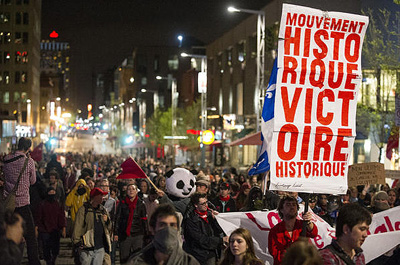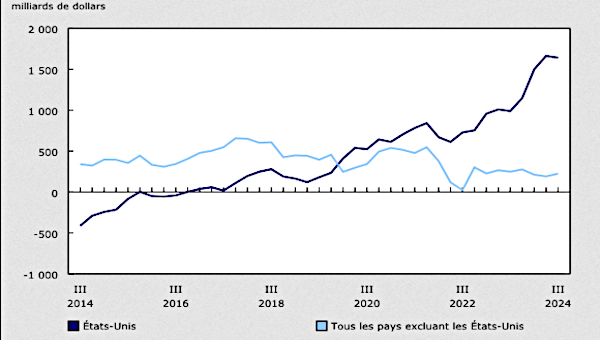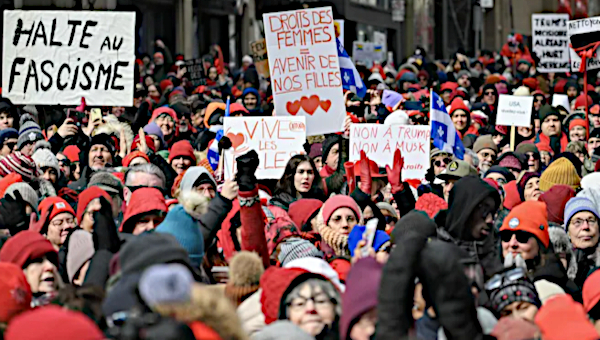Quebec Government Bludgeons Student Strikers With Emergency Law
But the Struggle Continues
Quebec premier Jean Charest announced May 16 that he will introduce emergency legislation to end the militant student strike, now in its 14th week, that has shut down college and university campuses across the province. The students are protesting the Liberal government’s 75 per cent increase in university tuition fees, now slated to take place over the next seven years.
 The special law, Charest said, will suspend the current session for the striking students and impose harsh penalties for those who in the future attempt to block physical access to campus premises or “disrupt” classes. It will not include the terms the government offered following a 22-hour marathon negotiating session May 4-5 – although, as we shall see below, we have not heard the last of some of those provisions. That offer was rejected overwhelmingly by the students in mass meetings held during the past week. In all, 115 associations representing 342,000 of Quebec’s 400,000 college and university students voted to reject it. Of these, more than 150,000 students are still on strike.[1]
The special law, Charest said, will suspend the current session for the striking students and impose harsh penalties for those who in the future attempt to block physical access to campus premises or “disrupt” classes. It will not include the terms the government offered following a 22-hour marathon negotiating session May 4-5 – although, as we shall see below, we have not heard the last of some of those provisions. That offer was rejected overwhelmingly by the students in mass meetings held during the past week. In all, 115 associations representing 342,000 of Quebec’s 400,000 college and university students voted to reject it. Of these, more than 150,000 students are still on strike.[1]
The law will effectively end the present strike, but without resolving any of the underlying issues. The immediate goal of the strike was to stop the tuition hike, but the strike also revived a major public debate over long-standing proposals in Quebec to expand access to university education through abolition of fees and to roll back the increasing subordination of higher education to market forces and private corporate interests. The government turned a deaf ear to the students on all these questions.
Repressive and Authoritarian Law
“The Liberals have spit on an entire generation,” said Gabriel Nadeau-Dubois, a spokesman for the CLASSE,[2] the largest student association. “It is a repressive and authoritarian law. It restricts the students’ right to strike, which has been recognized for years by the educational institutions.” The CLASSE has called for a massive march of students and their supporters, to be held May 22 in Montréal. It hopes the numbers mobilized in the streets will be comparable with the estimated 200,000 who came out on March 22 and the even greater number who assembled on April 22, Earth Day.
Equally outraged was the president of the national teachers union, the FNEEQ-CSN,[3] Jean Trudelle. “They talk of accessibility as if it was simply a question of opening the doors,” he said. The president of the university professors’ union, Max Roy, likewise denounced the government for failing to take the students’ concerns seriously.
Charest’s announcement came less than two days after education minister Line Beauchamp suddenly resigned not only from the cabinet but from her seat in the National Assembly, admitting that she was no longer “part of the solution” to a crisis that has shaken the government. Arrogant and obdurate to the end, Beauchamp said she had “lost confidence in the willingness of the student leaders to search for solutions and… a genuine way out of the crisis.” Premier Jean Charest promptly replaced her with Michèle Courchesne, a former education minister.
“The problem for us has never been Ms. Beauchamp,” said CLASSE spokesman Nadeau-Dubois. “The problem is the hike in tuition fees. And it is not by changing the minister… that the present crisis will be solved. The crisis will be solved when they agree to talk about the reason why the students are on strike, that is, the increase in tuition fees.”
Charest’s Self-Imposed Crisis
The minister’s resignation underscored the depth of the crisis the Charest government has brought upon itself. For months it tried to trivialize the strike, ignoring the students’ demands, refusing to negotiate, evidently hoping the movement would exhaust itself, especially as the current spring session approached its end with no resolution in sight. But even as they faced loss of their session credits if the strike continued, the students for the most part held firm, successfully mounting defiant mass pickets at many campuses and frustrating more than 30 court injunctions to reopen the institutions, often in the face of massive police violence and multiple arrests. Well over one thousand students have been arrested – a total that far exceeds the previous record arrests in the 2010 G20 protests in Toronto – and many face criminal charges for disruptive tactics or defiance of police orders to disperse.
In recent weeks they have marched each night, usually in the thousands, through the streets of Montréal, in colourful impromptu demonstrations that play cat-and-mouse with police attempts to control their route. It is the “Printemps érable” – the “maple spring” that is the Quebec version of the Occupy movement – in this case occupying the streets of the province’s metropolis.
Although the government and the corporate media have worked relentlessly in recent months to turn public opinion against the students, there were signs that the students’ militant resistance was opening breaches in this strategy. A Léger Marketing poll published May 11 reported that 71 per cent of those interviewed think the government has “mismanaged” the conflict. Another Léger poll found that Francophones (more than 80 per cent of the province’s population) and those under 55 years of age tended to hold the government and not the student associations responsible for the failure to settle the crisis.[4]
The portrayal of the students’ struggle as a self-serving attempt to avoid paying “their fair share” of education expenses is falling flat on its face. Le Devoir columnist Michel David was simply stating the obvious when he concluded: “If so many young people are prepared to sacrifice their session, it is manifestly because they feel they are defending a cause that goes beyond their individual interests.”
As David noted, the strike is showing signs of becoming one of those epochal moments in Quebec’s evolution, a “catalyst,” as he put it, for a burgeoning movement of protest challenging the current direction of the society. His take on this is worth quoting at some length:
“Any society periodically experiences a conflict that captures the imagination and then becomes a sort of landmark. In recent decades Quebec has been marked by the asbestos strike, the strike of the Radio-Canada producers, or the strike by the United Aircraft workers.[5]
“The student strike could well become one of these landmarks. What was initially claimed to be a mere budgetary item has had a catalytic effect on the frustrations of those who are fed up with hearing the ‘lucides’ associate the social-democratic values inherited from the Quiet Revolution with opposition to change or the status quo. […][6]
“It is true that the gradual rehabilitation of the ‘solidaire’ discourse in public opinion began before the student conflict. The world financial crisis, which has spectacularly enhanced the role of the state, the movement of the ‘indignés,’ and the right-wing policies imposed by the Harper government have disturbed people, but the red square [the red felt flash worn by striking students] has clearly favoured the link with what was once called the ‘forces vives,’ the living forces of the society.”
Like any mass struggle of such scope, the student strike has also challenged the existing political forces in Quebec society to declare where they stand. The only party strongly supporting the students, the left-wing Québec solidaire, calls for free education from kindergarten to university.[7] Responding to Charest’s announcement May 16, Amir Khadir, the QS member of the National Assembly, declared his party’s solidarity “more than ever, on the side of the students” and promised to fight any attempt to criminalize dissent. And he added:
“Québec solidaire strongly believes that … the student movement in Quebec has won, in that it has changed Quebec. The movement has won through its intelligence, its unity, by putting a freeze on tuition fees and even free university education at the centre of the debate on education, and education at the centre of political debate.
“Whatever the decision of the student movement on its conduct in the face of the special legislation, we are going to respect it. We are going to accompany this movement and defend it as best we can. Whatever happens in the coming months, the students’ struggle is not finished, and will enter new stages, and our party will be in solidarity with it.”
Ranged solidly against the students are not only the Liberals but the new right-wing Coalition Avenir Québec led by former Parti Québécois minister François Legault, who has been calling for increased police repression and other measures to break the strike.
Somewhere in the middle is the official opposition party, the PQ, which appears to be caught between two stools. PQ members of the National Assembly sport the red square badge of support for the students, to the obvious irritation of Premier Charest and his ministers. But PQ leader Pauline Marois calls only for an “indexed freeze” on current tuition fees – somewhat less than what the PQ congress of April 2011 demanded: a restoration of the freeze at 2007 levels until a summit on higher education is held and legislation is adopted governing tuition fees and incidental fees.
However, at the opening of the PQ national council in early May, Marois said that in the forthcoming elections Québécois will have to choose between “everyone for himself” and the “culture of mutual assistance.” Could she be looking over her left shoulder at Québec solidaire?
Doing Unionism Differently?
Also tested in this struggle have been the major social institutions of the 99%, Quebec’s trade unions, which continue to represent almost 40% of the province’s workers and a substantial majority of its public and parapublic sector employees. The union centrals are coming under increasing criticism for their approach to the strike – one of lukewarm and largely symbolic support to the students, but at crucial points of doubtful assistance. Details are now emerging of the role played by the leaders of the major union centrals in the May 4-5 negotiations between the students and government, to which they were invited as “advisors” to the students.
Although all three (FTQ, CSN and CSQ[8]) told the ministers they supported the student demands – the CSN said it had supported free tuition for 40 years – it appears from the CLASSE account[9] that the union leaders
- accepted the government move to focus a “solution” to the strike on reduction of university expenses, possible reductions in incidental fees, but not tuition fees;
- counselled the students more than once not to “go too far” in their demands;
- joined with the government negotiators in rejecting a student request after more than 12 hours of meeting for a break in which to get some rest and consult mutually on details of the proposed agreement;
- later lauded the government offer – while the government termed it an “agreement,” the unions termed it a “road map” toward a settlement – as “good news” for the people of Quebec.
Writing in the left-wing online journal Presse-toi-à-gauche, a publication not in the habit of criticizing the union leadership, René Charest noted the similarity between this “road map” and the sweetheart public sector union agreement negotiated by the union leadership in 2010. The latter agreement made a possible wage increase – mainly at the end of the contract, five years later – contingent on the union’s ability to demonstrate sufficient growth meanwhile in Quebec’s GNP.
“The negotiated agreement on the tuition fee hike, for its part, said it would have to be demonstrated that there were possible savings in order to decrease the incidental fees. In both cases, these agreements acknowledge that the financial framework is insufficient to meet the requirements of the contending parties. … [T]he Liberal government’s device was to tell the students: Pay up or help us rationalize the university: either way, it’s win-win for the entrepreneurial state. You could say the same thing about the union movement in the public sector: ‘If you want to earn more help us reorganize the public finances.’ […]
“What is the role of the union movement in this social struggle being led by the student movement? We don’t really know what happened in the corridors, although some journalists have begun to publish some interesting facts. One thing is clear, however. There has been no real dialogue between the student movement and the union movement since the beginning of this strike, or else we would not have had this tragicomic episode. Yet a strategic dialogue could have begun two years ago when the Coalition contre la tarification et la privatisation des services publics began the battle against the [first] Bachand budget. […]
“And this strategic dialogue could have taken place after the CSN congress last spring. We recall that a member of the Montreal hospital union came to defend a proposal for a social strike against the neoliberal measures of the Charest government. She hadn’t even finished her speech when the hall erupted. A standing ovation, no less! Two or three delegates from the CSN apparatus (central council and FNEEQ) spoke in favour. Then Pierre Patry, a member of the executive, spoke in support, along the following lines: we will support the students and then debate the mandate for the social strike. The next day the new president Louis Roy called for discussing the need for the social strike in the workplaces. Since then, we have heard no echo of this call for a social strike.
“It is not too late to do the right thing. The student movement has no need for mediators or facilitators. It needs the solid support of the union movement as a whole. Perhaps it is time to think of doing unionism differently. That is, to lead a union struggle that is plugged into the social struggles and vitality of the mobilization, and not to the fossilized bureaucratic structures of the entrepreneurial state.”
Professors Join in Denouncing May 5 ‘Agreement’
It should be noted that, contrary to what I reported previously[10] on the basis of press reports, the university professors’ union was excluded from the May 4-5 negotiations and did not support the government “agreement.” In a news release published on May 9, the FQPPU[11] complained that it was therefore prevented from expressing the views of the professors, “whose work will nevertheless be indispensable when courses resume.” And it concludes: “In view of the absurdity of this situation and the trivializing of the issues that has appeared in recent months, the FQPPU does not support the agreement announced on May 5.”
An op-ed commentary on the terms the government had offered, co-signed by FQPPU president Max Roy, published in Le Devoir May 9, gave a “fail” grade to “this travesty,” and called the proposed provisional council “a bad joke” that would “trade off problems of university mission and orientation as simple problems of management.” Furthermore, it would “completely obliterate the meaning of what we do, the preservation of a university that is a genuine collective good, a genuine public service for our entire community.” The proposal as a whole, the authors noted, “offers an accounting solution to a problem that must be resolved in terms of a ‘societal choice’.”
Given the social polarization that resulted, many have questioned why the Charest government has held so stubbornly to its decision to hike the fees – even while advertising repeatedly that the increase, spread over seven years and minus a tax credit, would add only “50 cents a day” to the student bill. In fact, even free post-secondary education, as demanded by many students and professors, would cost barely 1 per cent of the total government budget, according to most estimates.
It seems that shifting the costs of higher education increasingly to the students is as much a principle for the government’s post-secondary education planners as abolishing those fees is a principle for many students and professors. Why is this? Some indication may be gained from articles by Pierre Dubuc, editor of L’aut’journal, who draws on research by Philippe Lapointe, a leader of the CLASSE.[12] Dubuc summarizes the research in an article in the May 17 on-line issue of L’aut’journal. Here is the article, in my translation.
Charest Wants to Transform Quebec Into a “Right-to-Study State”
Pierre Dubuc
Maintaining the increase in tuition fees, suspending courses and disqualifying student organizations. With its special law, the text of which is unknown at time of writing, the Charest government continues its effort to integrate Quebec universities in the world university network in accordance with the neoliberal principles of the Bologna process, and transform Quebec into a “Right-to-study state” on the model of the “Right-to-work states” of the southern United States.
In the agreement of last May 6, now obsolete, the minister Courchene slyly introduced, in article 2, the creation of a Permanent Universities Council with a mandate to examine “in light of the best practices” such topics as “abolition and creation of programs, internationalization, partnerships between the universities and the communities, continuing education, the quality of training, research, support and university bodies.”
Close observers of the universities saw in this clause – which has no obvious link to the issue of tuition fees – a desire by the government to comply with the Bologna process. The latter derives its name from a conference held in Bologna in June 1999 in which 29 European countries signed a document that envisaged the creation of a European common space for higher education.
This process is divided into three major reforms. First, standardize studies into three cycles. Second, establish a single system for calculating university credits that are transferable between institutions. Third, institute quality assurance, under the management of agencies external to the universities.
In Quebec, the first two reforms are already in place, apart from the non-compliance of the CEGEP network, hence the repeated calls for its abolition – most recently from the CAQ of Sirois-Legault – and its restructuring on the model of the “colleges” in English Canada.[13]
In Europe, this reform, which is modelled on the American universities, presents education as a personal investment. It is accompanied by a substantial increase in tuition fees, with repayment proportional to income: exactly the measures put forward by the Charest government.
In this big global market, education is an industry and the universities are enterprises fiercely competing to attract international students. The Conférence des recteurs et des principaux des universités du Québec (CREPUQ) has identified, among its priority objectives, the need to “increase the resources to attract foreign students.”
Unsurprisingly, in the middle of the current conflict, the rectors of our universities did not hesitate to go to Brazil to recruit students. The Brazilian government has just announced that more than 100,000 Brazilian students will attend foreign universities over the next four years, at the expense of their government. Canada plans to attract 12,000 and the Quebec universities want “their fair share” of this windfall.
The international market in foreign students is expanding rapidly. In 2008, 3.3 million students were educated in countries other than their own. This is a 154% increase over a five-year period. And of course there is a strong demand for courses in English, which explains the inauguration of courses in English by the University of Montréal, its business school the HÉC and even UQAM, the Montréal campus of the University of Quebec.
In Quebec, the number of international students has risen from 9,135 in 2003 to 26,191 in 2010. Today, in the Quebec universities, close to one student in ten is an international student. For the Quebec universities and government, the international students “pay” much more than Quebec students, if we make an exception for students from France or other countries with which Quebec has agreements.
Overall, the university fees demanded of foreign students are about seven times higher than those paid by Quebec students. So why not replace Quebec students, ousted by the hike in tuition fees, with students from other countries?
But the fees paid by the international students, even subsidized, do not cover the actual costs of many courses such as medicine, engineering, etc. So we subsidize, through our taxes, a portion of the costs of these students, most of whom will return to their countries at the end of their studies.
Of course, there are other financial advantages for the host countries in accepting international students. They have to be housed, clothed, fed, entertained, etc. But the question is posed: Do these economic spinoffs and the tuition fees they cover compensate for the amount of the subsidy we pay to them?
The presence of international students is, to be sure, a source of cultural enrichment and Quebec has a duty, as a rich country, to welcome students from poor countries. We already have agreements with these countries that codify the disinterested assistance we give them.
However, the current market in international students is something else. It has all the characteristics of an industry and it illustrates perfectly the commodifying of education in the epoch of globalization. Evidently, the Charest government gives precedence to positioning our universities in the global hall of fame over the schooling of the Québécois.
Unfortunately for it, and fortunately for us, the students do not see it that way. Through their courageous and determined struggle against the tuition fee hike they are challenging the very foundations of this liberal vision of education.
For the government, the issue goes beyond the amount of the tuition fees. Thus it resorts to a special law in which primacy is given to individual rights over collective rights, in which a student’s “right to study” prevails over the collective decision of a student assembly.
This is exactly the situation experienced by workers and unions in the so-called right to work states, those former slave states in the South, where collective agreements are illegal and the unions are condemned to operate in the underground. Is that the fate that awaits the student organizations?
“The fight against neoliberalism has its specific national features. In Quebec, it proceeds through national independence. That alone has the potential to shake the structures of domination, to liberate the creative forces, and to be the leaven of social transformation at the level of North America.”
That the Charest government is attacking the right to association should be no surprise to us. There is a lock-out at the Rio Tinto Alma plant because the government opened the door to contracting out with the amendments to section 45 of the Labour Code in 2003. It let the company violate the spirit of the anti-scab law through the hiring of numerous management personnel prior to the conflict, and it allows Hydro-Québec to purchase the kilowatts of electricity freed up by the stoppage of two thirds of production.
The students’ struggle must be the struggle of all Québécois, of all their organizations. It should be taken to the political level and become part of the struggle for the emancipation of the Quebec people.
We will be unable to establish free tuition and improve our social programs while we continue to pay 20 per cent of the tens of billions awarded by the federal government for the operation of the tar sands, the Ontario automobile industry and the purchase of the F-35 fighter planes.
The fight against neoliberalism has its specific national features. In Quebec, it proceeds through national independence. That alone has the potential to shake the structures of domination, to liberate the creative forces, and to be the leaven of social transformation at the level of North America. •
Endnotes:
1.
For detailed results of the voting, see Résultats des votes sur la dernière offre du gouvernement.
2.
Coalition large de l’Association pour une solidarité syndicale étudiante [Broad coalition of the Association for student union solidarity]. Also participating in the strike were the Fédération étudiante universitaire du Québec; Fédération étudiante collégiale du Québec, and the Table de concertation étudiante du Québec.
3.
Fédération nationale des enseignants et enseignantes du Québec, which is part of the Confederation of national trade unions (CSN).
4.
See Michel David, “Le nouvel ennemi public,” Le Devoir, May 12.
5.
The 1949 strike in the asbestos industry fostered many of the social and political forces that initiated and led the Quiet Revolution a decade later, as did the Radio-Canada dispute in 1958. A major issue in the 20-month strike at United Aircraft (now Pratt & Whitney), in 1974-75, was the company refusal to allow deduction of union dues at source and later the use of scabs to break the strike. The violent strike ended without major gains for the workers, but was followed by a plant occupation. The PQ government elected soon afterwards allowed union dues deduction and introduced a still-popular anti-scab law.
6.
The lucides (clear-eyed) was the name adopted by a group of right-wing political and corporate leaders who issued a neoliberal manifesto in 2005, which was answered by a manifesto signed by prominent “progressives,” the solidaires, among them some of the founders of Québec solidaire in 2006.
7.
The QS proposals on post-secondary education are outlined in a leaflet that party members have been distributing during the student strike. Click here to see it.
8.
FTQ – Quebec Federation of Labour; CSN – Confederation of National Trade Unions; CSQ – Central of Quebec Trade Unions.
9.
It was also published, inter alia, in L’aut’journal. See also Gilbert Lavoie, “Qu’est-ce qui n’a pas marché entre le gouvernement et les étudiants?” in Le Soleil, May 12.
10.
“Defiant Quebec students reject shabby government offer,” note 2.
11.
Fédération québécoise des professeures et professeurs d’université. Founded in 1991, the FQPPU includes 15 unions and associations that represent more than 5,000 university professors.
12.
See Philippe Lapointe, “L’ironie de l’assurance-qualité,” first published in Ultimatum and republished in L’aut’journal.
13.
The CEGEPs – Collèges d’enseignement générale et professionnelle – are public post-secondary institutions with a general arts and science or occupational stream that is preparatory to university. Tuition is free in the CEGEPs, unlike the universities.





